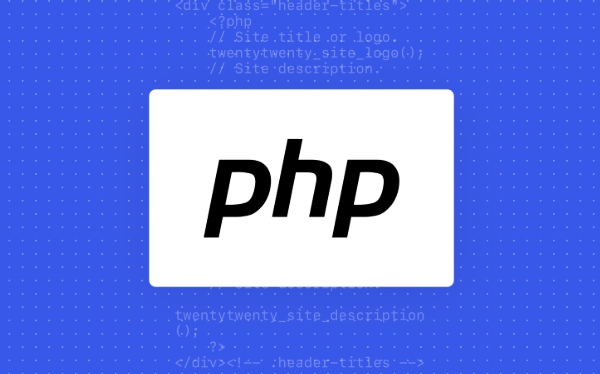Mastering Indexed vs. Associative Array Creation in PHP
Aug 02, 2025 am 08:55 AMIndexed arrays use numeric keys starting from 0, while associative arrays use named string keys; indexed arrays are created with $array = ['value1', 'value2'] and automatically assign integers, whereas associative arrays use $array = ['key' => 'value'] for meaningful labels; PHP preserves insertion order, but key type consistency matters, and mixing types is possible but not recommended for clarity; always check key existence with isset() or array_key_exists() and use var_dump() for debugging, with the choice between array types depending on whether data is sequential or labeled, ensuring cleaner, maintainable code.

When working with arrays in PHP, understanding the difference between indexed and associative arrays—and how to create them properly—is essential for writing clean, efficient code. While both types store collections of data, they serve different purposes and are created using slightly different syntax and logic.

What’s the Difference Between Indexed and Associative Arrays?
An indexed array uses numeric keys, starting from 0 by default, to store values in a linear sequence. These are ideal when the order matters or when you're dealing with simple lists.
$fruits = ['apple', 'banana', 'cherry'];
// Equivalent to:
$fruits = array('apple', 'banana', 'cherry');Here, 'apple' is at index 0, 'banana' at 1, and so on.

An associative array, on the other hand, uses named keys (strings) that you assign. This makes the data more readable and meaningful, especially when representing structured information like user data.
$user = [
'name' => 'John',
'age' => 30,
'city' => 'New York'
];These keys act like labels, making it easier to access values without remembering positions.

How to Create Indexed Arrays in PHP
Creating indexed arrays is straightforward. PHP automatically assigns numeric indices when you don’t specify keys.
- Use short array syntax
[](recommended for PHP 5.4 ) - Or the older
array()syntax for backward compatibility
$colors = ['red', 'green', 'blue'];
You can also manually assign numeric keys, even out of order:
$numbers = [0 => 'zero', 2 => 'two', 1 => 'one'];
PHP won’t reorder them—you’ll get the keys exactly as defined. If you later add an element without a key:
$numbers[] = 'three'; // This will be assigned key 3
PHP picks the next available integer (highest existing key 1).
Creating Associative Arrays: Best Practices
Associative arrays shine when you need to map descriptive keys to values. Always use the => arrow to link key to value.
$product = [
'id' => 123,
'name' => 'Laptop',
'price' => 999.99,
'in_stock' => true
];Keys can be strings or integers, but strings are most common. Avoid using quoted numbers unless necessary, as they become string keys:
$array = ['1' => 'one']; // string key $array = [1 => 'one']; // integer key
These are not the same in strict comparisons, though PHP often converts them silently.
You can mix both types in one array (though it's usually not recommended for clarity):
$mixed = [0 => 'first', 'name' => 'Sarah', 1 => 'second'];
This creates an array with both numeric and string keys.
Common Pitfalls and Tips
Don’t assume order: Although PHP preserves insertion order, relying on it can be risky in older versions or when modifying arrays.
Check key existence safely: Use
isset()orarray_key_exists()before accessing associative array elements.if (isset($user['email'])) { echo $user['email']; }Use
var_dump()orprint_r()to inspect array structure during development.When building arrays dynamically, be consistent with key types to avoid confusion.
Also, remember that all PHP arrays are technically ordered maps—they can contain both indexed and associative elements internally. But how you create and use them defines their practical type.
Basically, choose indexed arrays for lists and sequences, and associative arrays for labeled data. Mastering when and how to use each leads to more maintainable PHP code.
The above is the detailed content of Mastering Indexed vs. Associative Array Creation in PHP. For more information, please follow other related articles on the PHP Chinese website!

Hot AI Tools

Undress AI Tool
Undress images for free

Undresser.AI Undress
AI-powered app for creating realistic nude photos

AI Clothes Remover
Online AI tool for removing clothes from photos.

Clothoff.io
AI clothes remover

Video Face Swap
Swap faces in any video effortlessly with our completely free AI face swap tool!

Hot Article

Hot Tools

Notepad++7.3.1
Easy-to-use and free code editor

SublimeText3 Chinese version
Chinese version, very easy to use

Zend Studio 13.0.1
Powerful PHP integrated development environment

Dreamweaver CS6
Visual web development tools

SublimeText3 Mac version
God-level code editing software (SublimeText3)

Hot Topics
 PHP Variable Scope Explained
Jul 17, 2025 am 04:16 AM
PHP Variable Scope Explained
Jul 17, 2025 am 04:16 AM
Common problems and solutions for PHP variable scope include: 1. The global variable cannot be accessed within the function, and it needs to be passed in using the global keyword or parameter; 2. The static variable is declared with static, and it is only initialized once and the value is maintained between multiple calls; 3. Hyperglobal variables such as $_GET and $_POST can be used directly in any scope, but you need to pay attention to safe filtering; 4. Anonymous functions need to introduce parent scope variables through the use keyword, and when modifying external variables, you need to pass a reference. Mastering these rules can help avoid errors and improve code stability.
 How to handle File Uploads securely in PHP?
Jul 08, 2025 am 02:37 AM
How to handle File Uploads securely in PHP?
Jul 08, 2025 am 02:37 AM
To safely handle PHP file uploads, you need to verify the source and type, control the file name and path, set server restrictions, and process media files twice. 1. Verify the upload source to prevent CSRF through token and detect the real MIME type through finfo_file using whitelist control; 2. Rename the file to a random string and determine the extension to store it in a non-Web directory according to the detection type; 3. PHP configuration limits the upload size and temporary directory Nginx/Apache prohibits access to the upload directory; 4. The GD library resaves the pictures to clear potential malicious data.
 Commenting Out Code in PHP
Jul 18, 2025 am 04:57 AM
Commenting Out Code in PHP
Jul 18, 2025 am 04:57 AM
There are three common methods for PHP comment code: 1. Use // or # to block one line of code, and it is recommended to use //; 2. Use /.../ to wrap code blocks with multiple lines, which cannot be nested but can be crossed; 3. Combination skills comments such as using /if(){}/ to control logic blocks, or to improve efficiency with editor shortcut keys, you should pay attention to closing symbols and avoid nesting when using them.
 How Do Generators Work in PHP?
Jul 11, 2025 am 03:12 AM
How Do Generators Work in PHP?
Jul 11, 2025 am 03:12 AM
AgeneratorinPHPisamemory-efficientwaytoiterateoverlargedatasetsbyyieldingvaluesoneatatimeinsteadofreturningthemallatonce.1.Generatorsusetheyieldkeywordtoproducevaluesondemand,reducingmemoryusage.2.Theyareusefulforhandlingbigloops,readinglargefiles,or
 Tips for Writing PHP Comments
Jul 18, 2025 am 04:51 AM
Tips for Writing PHP Comments
Jul 18, 2025 am 04:51 AM
The key to writing PHP comments is to clarify the purpose and specifications. Comments should explain "why" rather than "what was done", avoiding redundancy or too simplicity. 1. Use a unified format, such as docblock (/*/) for class and method descriptions to improve readability and tool compatibility; 2. Emphasize the reasons behind the logic, such as why JS jumps need to be output manually; 3. Add an overview description before complex code, describe the process in steps, and help understand the overall idea; 4. Use TODO and FIXME rationally to mark to-do items and problems to facilitate subsequent tracking and collaboration. Good annotations can reduce communication costs and improve code maintenance efficiency.
 Quick PHP Installation Tutorial
Jul 18, 2025 am 04:52 AM
Quick PHP Installation Tutorial
Jul 18, 2025 am 04:52 AM
ToinstallPHPquickly,useXAMPPonWindowsorHomebrewonmacOS.1.OnWindows,downloadandinstallXAMPP,selectcomponents,startApache,andplacefilesinhtdocs.2.Alternatively,manuallyinstallPHPfromphp.netandsetupaserverlikeApache.3.OnmacOS,installHomebrew,thenrun'bre
 Learning PHP: A Beginner's Guide
Jul 18, 2025 am 04:54 AM
Learning PHP: A Beginner's Guide
Jul 18, 2025 am 04:54 AM
TolearnPHPeffectively,startbysettingupalocalserverenvironmentusingtoolslikeXAMPPandacodeeditorlikeVSCode.1)InstallXAMPPforApache,MySQL,andPHP.2)Useacodeeditorforsyntaxsupport.3)TestyoursetupwithasimplePHPfile.Next,learnPHPbasicsincludingvariables,ech
 How to access a character in a string by index in PHP
Jul 12, 2025 am 03:15 AM
How to access a character in a string by index in PHP
Jul 12, 2025 am 03:15 AM
In PHP, you can use square brackets or curly braces to obtain string specific index characters, but square brackets are recommended; the index starts from 0, and the access outside the range returns a null value and cannot be assigned a value; mb_substr is required to handle multi-byte characters. For example: $str="hello";echo$str[0]; output h; and Chinese characters such as mb_substr($str,1,1) need to obtain the correct result; in actual applications, the length of the string should be checked before looping, dynamic strings need to be verified for validity, and multilingual projects recommend using multi-byte security functions uniformly.






